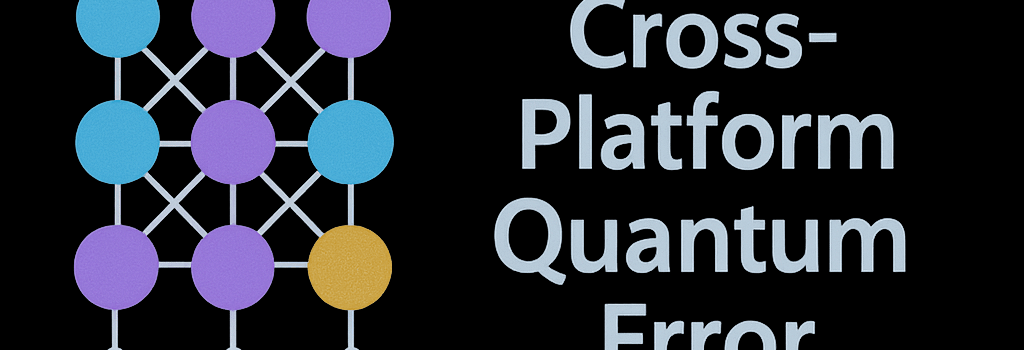Azure Quantum’s Cross-Platform Quantum Error Correction Blueprint

Microsoft’s Azure Quantum team has unveiled a unified quantum error correction (QEC) architecture designed to work across diverse qubit technologies. By leveraging four-dimensional geometric codes and arbitrary atomic or ionic connectivity, Azure Quantum aims to convert noisy physical qubits into robust logical qubits at error rates below 10–6. This article expands on the technical underpinnings, hardware integration challenges, and comparative perspectives on QEC schemes from leading vendors.
1. Platform-Agnostic Error Correction Strategy
Rather than tying its QEC stack to a single qubit modality, Microsoft has chosen a family of 4D hypercubic codes that can be mapped to chip-based superconducting devices, trapped-ion chains, or neutral-atom arrays. Key parameters include:
- Physical qubit error rate: ~1×10–3 per gate or measurement
- Logical qubit target rate: 1×10–6 or better
- Code distance (d): 8 for Hadamard variant, scalable to d=12–16
- Overhead: 96 physical → 6 logical qubits (Hadamard), 144→12 logical (distance-12)
By abstracting the code as a 4-torus lattice TΛ4, Microsoft provides formal proofs of threshold and single-shot decoding performance in its recent preprint.
2. Arbitrary Connectivity in Atomic and Ionic Systems
Unlike fixed-layout superconducting chips, neutral-atom and trapped-ion platforms support dynamic qubit shuttling and photon-mediated gates. Azure Quantum’s codes exploit this by embedding each qubit node in 4D connectivity:
- Nearest-neighbor routing: Atoms are rearranged via optical tweezers with sub-μm precision to establish edges of the 4D hypercube.
- Long-range photonic links: Quantum frequency conversion at 1,550 nm enables entanglement between distant nodes, reducing SWAP overhead.
- Mid-circuit routing: Ion chains actively reconfigure gates without complete decoherence, leveraging magnetic field–insensitive hyperfine states.
3. Single-Shot Decoding and Weak Measurements
One of the standout advantages of this code family is its single-shot syndrome extraction. As Krysta Svore, Director of Quantum Software at Microsoft, explains:
“With only 1–2 rounds of weak measurements, the decoder can identify and correct Pauli errors with high confidence, keeping measurement-induced heating or depopulation to a minimum.”
In neutral-atom machines, weak measurement involves Raman sideband cooling zones at 852 nm where qubits are read out via fluorescence without full wavefunction collapse. This approach limits atom loss to <1 percent per cycle, as demonstrated by Atom Computing’s recent mid-circuit measurement tests.
4. Logical Gate Set and Universal Computation
To support universal quantum algorithms, Azure Quantum’s scheme defines native logical operations on encoded qubits. Supported gates include:
- Clifford gates: X, Z, H, S via transversal application across the 4D lattice
- Two-qubit entangling gates: Logical CNOT via lattice surgery on adjacent code blocks
- Non-Clifford T-gate: Magic state distillation within dedicated ancilla cubes, overhead ≈15× per logical qubit
These operations have been simulated on up to 500 physical qubits with projected logical error rates below 10–9 for deep circuits.
5. Hardware Integration Challenges
Microsoft’s QEC blueprint awaits deployment on next-generation hardware. Key integration hurdles include:
- Laser stability: Neutral-atom traps require lasers with <200 Hz linewidth and <1 kHz drift to maintain coherence over 1000 μs gate times.
- Vacuum lifetime: Background gas collisions limit atom retention to ~30 s; active replacement must outpace loss.
- Control electronics: FPGA latencies for mid-circuit decision making must remain below 500 ns to avoid decoherence during syndrome extraction.
6. Comparison with Alternate QEC Roadmaps
IBM’s superconducting approach uses surface codes on 2D lattices, requiring custom chip wiring for each code distance. In contrast:
- Azure Quantum’s 4D codes reduce SWAP gate chains by up to 75 percent on atomic platforms.
- IonQ’s recent roadmap targets 512-ion linear traps by 2026, which could implement distance-10 variants of 4D codes with fewer control channels.
- Quantinuum is exploring color codes on 3D ion crystals, offering faster magic state injection but higher ancilla overhead.
7. Expert Perspectives
Dr. Laura Sinclair, Quantum Information Theory Chair at MIT, notes:
“Four-dimensional codes map elegantly onto both optical and electronic qubit networks. The single-shot property is especially promising for platforms with slow cooling cycles.”
IonQ CTO Jungsang Kim adds:
“Our forthcoming 256-ion system will test these schemes at scale. Real-world validation is critical, particularly for multi-round decoders.”
8. Future Outlook and Roadmap
Azure Quantum’s next steps hinge on partner hardware rollout:
- Atom Computing collaboration: 1,200-atom array in 2026, expanding to 10,000 in 2027, to host >100 logical qubits.
- PASQAL upgrade: From 100 to 512 neutral atoms with spectral multiplexing by early 2026.
- Hybrid simulators: Exa-scale cloud emulation of 4D codes for application benchmarking.
9. Conclusion
Microsoft’s Azure Quantum error correction architecture offers a versatile, mathematically rigorous path toward fault-tolerant quantum computing. By unifying support for superconducting chips, trapped ions, and neutral atoms, and by adopting high-dimensional code geometries with single-shot decoding, the platform stands ready to adapt as hardware advances. Upcoming hardware deployments from Atom Computing, IonQ, and Quantinuum will provide the empirical results needed to validate these promising schemes.